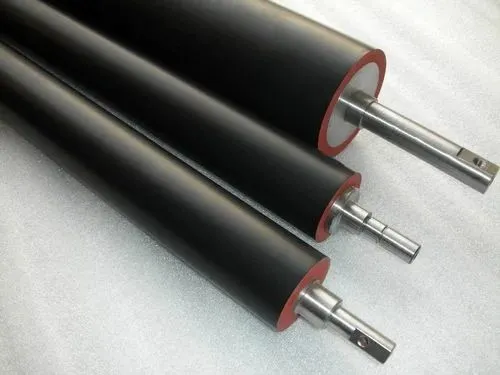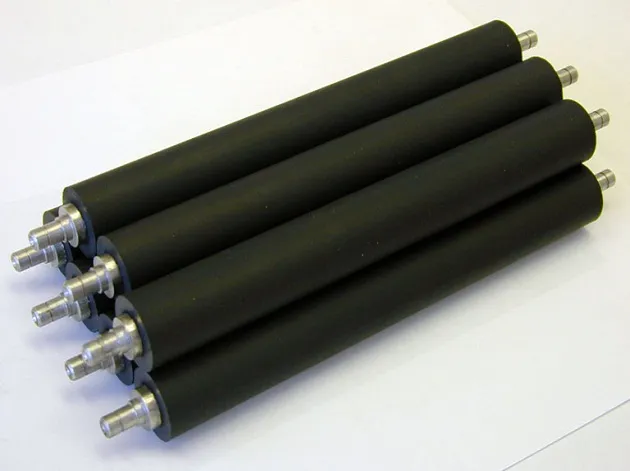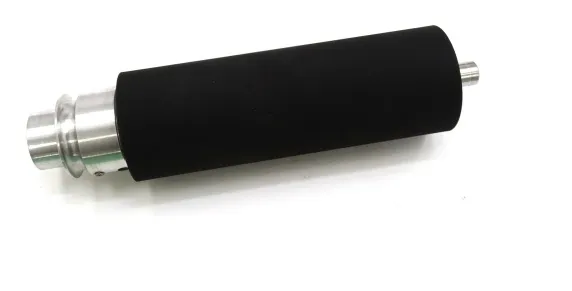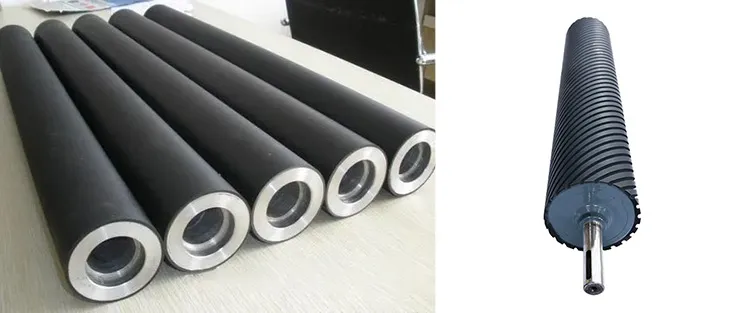Rubber rollers are an important industrial accessory used in many different applications. There are many types of rollers used because they can simplify production operations with outstanding advantages.
What is a rubber roller?
Rubber rollers (rubber-coated rollers) are an important part of the conveyor system. They consist of a core made of steel, aluminum or synthetic metals and are covered with a layer of rubber on the outside. This rubber layer can be of many different types such as polychloroprene, nitrile, EPDM, etc., depending on the needs of use.
Rubber-coated rollers have high elasticity, good hardness, withstand strong impacts and can be supplied in many different sizes and shapes to suit specific applications.

Rubber Covered Rollers are an important part of the conveyor system
Structural characteristics of rubber rollers
The two main parts of the roller are the roller core and the rubber cover. The roller core is the main structural member that is connected to the main drive. On the other hand, the rubber cover is the member that is pressed against the load. These parts are manufactured according to the standard with the required size of use:
1 - Roller core
The roller core is a rigid structural member that supports the load. It is usually made of high-strength materials such as carbon steel, stainless steel, alloy tool steel and aluminum alloy. The roller core is designed according to their application. They can be divided into many parts.
- Roller core shaft: The shaft is the machine part that connects the entire roller to the motor, sprocket or other transmission parts. It is solid in construction, with high strength and uniform hardness. The shaft is designed to withstand bending and torsional stresses.
- Roller Core Cylinder: The cylinder is a hollow section, usually in the form of a tube or pipe. This is where the rubber liner is wrapped and bonded. It has enough thickness to resist deformation when a load is applied. The cylinder is usually made from steel, but other strong but lightweight materials, such as aluminum and reinforced plastic, can also be used.
- Roller Core Flange: The flange or end plate that connects the cylinder to the shaft. The shaft, cylinder, and flange are usually held together by welds. In some cases, the flanges are pressed into place and held by a resistance fitting, which is common on smaller roller assemblies.
- Roller Core Bearing: A bearing used to reduce friction with stationary and rotating components. The configuration, mounting, and type of bearing can vary depending on the design of the roller. The configuration described above has the shaft mounted along with the roller cylinder. In other designs, the bearing may be mounted on the roller while the shaft is stationary on the main unit.
2 - Roller cover:
The rubber liner is the outer shell that comes into contact with the load or material being handled. This part wears the most to protect the roller core and the load surface. The type of rubber material and grade depends on the application of the roller. Rubber types have many different features, hardness, abrasion resistance, heat resistance, acid and alkali resistance, toughness, oil resistance, solvent resistance, etc.
Commonly used types of rubber rollers today
There are many different types of rollers, each suitable for a specific application:
- Smooth rubber roller
Rollers with smooth, flat, rubber surfaces are the most common type of roller. With a smooth surface, this type of roller has many advantages such as easy cleaning, reduced friction and lower cost.
The application of smooth rubber-coated rollers makes them operate more smoothly, without causing abrasion to the moving material. Commonly used in papermaking, printing, packaging, and many other industrial applications.

Smooth rubber rollers reduce friction during material movement
- Grooved rubber rollers
These are rollers with grooved rubber surfaces to increase efficiency for some special applications such as in wet or harsh environments. Grooved rubber rollers increase material adhesion, reducing the risk of slipping better.
However, this type of roller is also more difficult to clean due to the deep grooves. Due to the application in dusty environments, the roller can wear out faster. The cost of grooved rubber rollers is also higher than that of smooth rollers.

Grooved rubber rollers increase adhesion, effectively reducing slipping
- Drive rubber rollers
Used to drive conveyors. They operate through rotation, directly interacting with a motor to ensure the drive rollers run smoothly. This type of roller helps high transmission efficiency in conveyors. Helps the conveyor operate smoothly, with little noise

Rubber drive rollers for efficient transmission of conveyors
- Heat-resistant rubber-coated rollers
Used in high temperature environments, usually from 100°C to 300°C. Specially constructed with a metal core covered with a layer of heat-resistant rubber such as silicone, EPDM, ... these types of rubber have good heat resistance and maintain flexibility at high temperatures.

High temperature silicone-coated rubber rollers
Outstanding advantages of rubber rollers
- Rubber materials are characterized by a high level of flexibility and elasticity. Rubber compounds are widely used due to their good shock and sound absorption, impact resistance and good recovery properties.
- Excellent abrasion and chemical resistance, high temperature resistance.
- Rubber coated rollers have a distinct advantage, they have a soft coating that provides a firm grip for better traction while providing additional protection for goods moving on conveyor systems.
- High durability and shock absorption while being more elastic than standard metal rollers.
- Natural properties with flexibility allow weight to be distributed evenly throughout the roller, instead of the pressure being concentrated at the point of contact.
Applications of rubber coated rollers
With outstanding advantages, rubber rollers are an important device that contributes to improving production efficiency, transportation and cost savings in many different industries.
1 - Rubber rollers in conveyor systems
Rubber-coated rollers play an important role in conveyor systems, contributing to the efficient transportation of raw materials and products in the production line. Thanks to their high load-bearing capacity, anti-adhesion and anti-static properties, rubber conveyor rollers are widely used in many industries, providing optimal material transmission efficiency.
Advantages of rubber conveyor rollers:
- Rubber conveyor rollers are made from high-quality materials, capable of withstanding large loads, ensuring safe transportation of all types of materials.
- The outer rubber layer helps the roller limit material adhesion, minimizing friction and slippage during transportation.
- Rubber conveyor rollers help transport materials smoothly and quietly, limiting noise and loss.
Applications of rubber conveyor rollers: Used in many industries such as: manufacturing, food processing, textiles, footwear, electronics, warehousing, logistics, etc.
2 - Rubber rollers in machinery
- Rubber rollers help improve grip and prevent slipping on production machinery, carts, and moving equipment.
- The roller helps to open and close gates and doors smoothly and gently.
Instructions for using rubber-coated rollers properly
- First, you need to follow the manufacturer's instructions on rubber-coated rollers for the most accurate use
- During use, pay attention to ensure that the roller is not damaged, cracked or worn.
- Do not use the roller to transport materials that are overloaded, avoid strong impacts
- Clean the roller periodically to remove dirt and other adhesives.
- Check the roller periodically to detect and repair damage promptly.
- Lubricate the roller periodically to ensure smooth operation and reduce friction.
- Replace the roller when necessary to ensure efficiency and durability.
How much does a rubber roller cost?
The price of a rubber roller can vary depending on the size, material and brand of the product. However, the average price of a rubber roller usually ranges from 50,000 - 100,000 VND.
If you want to buy a rubber roller, it is best to research and compare prices from many suppliers to get the best price and the best quality product for your needs.
Intech Group provides reputable rubber rollers at good prices
The applications of rubber rollers are very diverse, they can be customized in size, shape and material to suit specific requirements. Choosing the right roller is crucial to ensuring performance, durability and safety.
At Intech, we have many years of experience in manufacturing high-quality rollers. Continuous improvement has enhanced our ability to meet the stringent requirements of our Customers.
Intech Group's capabilities will help you achieve high-standard roller products:
- Proposing and developing calculations to suit the specific requirements of your operating environment: wear resistance, tear resistance, chemical resistance, static discharge, high temperature stability, etc.
- Our flexibility and manufacturing experience allow us to tailor manufacturing methods to suit your exact roller, resulting in efficient production regardless of volume.
- Work with your engineering staff to develop prototypes and quickly bring new designs into production.
- Providing the highest quality metal cores
Contact Intech for advice and quotation:
- Hotline: 0966 966 032
- Address: Lot 6, Lai Xa Industrial Cluster, Tay Tuu Ward, Hanoi City






